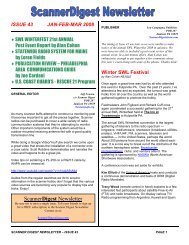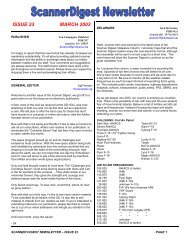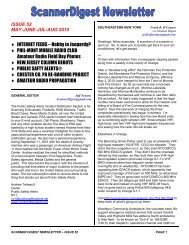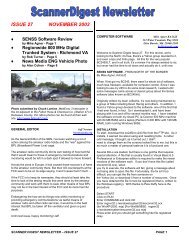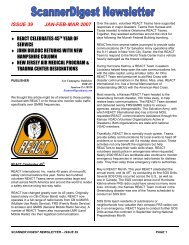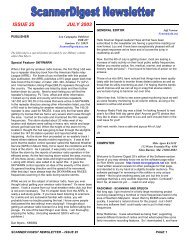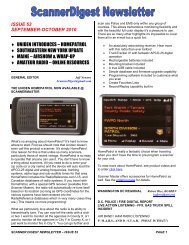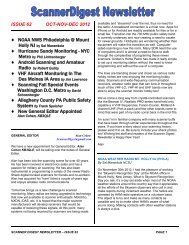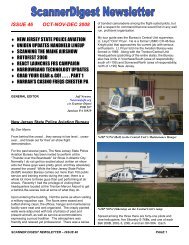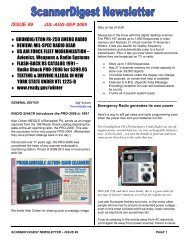lower as it moves away. The siren itself is always thesame, but our perception of it changes as it moves inrelationship to us.The same effect happens when listening to radio signalstransmitted by a satellite. As the satellite approaches it isbest received on one frequency, but as it comes directlyoverhead it is on another, and when moving away itmoves to another frequency. When using handheldradios/scanners you will need to make these adjustmentsmanually. Fortunately these adjustments are small, andyou can either tune them in manually or program specificchannels for the shift frequencies and just change to themas needed.Fortunately, a satellite (nor the ground station iftransmitting) needs to use much power to be heard.Satellites can use 1 or 2 watts of power (sometimes evenless) to be received on earth. Five watts from a handheldhere on earth can reach the satellite easily, so power isnot really an issue. Since much of the distance involvesthe vacuum which is space, signals are not obstructed orbounced, thus lowering the power required to transmit.Finally, since satellites operate primarily in the VHF orhigher range, the normal RF issues apply here as they dowith any VHF or higher transmission. The same weatherconditions which affect 6-meter and above contacts mayalso affect satellite contacts, as well as other atmosphericand ground-based interference. While this means treesand other obstructions can prevent line-of-sightcommunications, the higher frequencies are less prone tostatic and other interference common in the lower bands.This makes satellite contact a fairly reliable means ofcommunication, all things considered.Basic EquipmentI doubt back in 1961 when folks started listening toamateur satellites they would have ever dreamed theycould work a bird with nothing more than a handheld radioand a basic telescoping antenna. Many folks, myselfincluded, have labored under the mistaken belief that towork a satellite or the space station one needed complexantennas or a satellite dish like those popularized in spacemovies. Every day of the week folks hear or makecontacts with satellites using very minimal equipment, sodon’t hesitate to use what you already have.I recommend starting out simple and building up yourcapabilities as your interest and/or budget allows. Makeuse of your handheld radio as nothing beats its portability.Depending on the bird you are listening to, a single bandor dual band radio will be required, along with an antennawhich has a bit of gain.ready for this!) . . . a tape measure and some PVC tubing!Do an Internet search for “tape measure antenna” and youwill find lots of homebrew options for a good satelliteantenna.I use a dual bandArrow antenna, acommercialoffering, and onethat has a greatreputation forworkingsatellites. While Iwould nothesitate to buildmy own thesedays, I got thissoon after gettinginto AmateurRadio because Iknew workingsatellites wasone of first thingsI wanted to try.There are alsoother manufacturers who put out a good quality antenna,so don’t hesitate to buy a decent antenna if you are notready to build your own. If you do a YouTube search youcan find several folks who have done greatdemonstrations for using antennas like this, so be sure tocheck them out!Some satellites broadcast their uplink and downlinkfrequencies on the same band, while others receive onUHF and transmit on VHF, and so on. As an example, asatellite may have this listed for its frequencies: Uplink FM145.920, 67Hz PL Downlink FM 435.300 A dual bandradio with built-in diplexer can be useful, but two monobandreceivers work well also. This is the setup I use mostoften, as the antenna I use has dual connectors forVHF/UHF.I like the simplicity of such a setup as it makes it easy tohear the receive portion while I transmit. It is a bit moreawkward to handle two radios, but I built a platform whichmounts to a tripod to hold the radios while I focus onpointing the antenna.While a rubber duck can work, it is extremely limited. Atelescopic whip will do better. Better still, a handheldantenna like the one shown below will work quite well. Asimilarly styled dual band antenna can be made out ofthings you may have around the house like . . . (are youSCANNER DIGEST NEWSLETTER – ISSUE <strong>58</strong> PAGE 12
ResourcesHeavens Above Satellite Flyover Pagehttp://www.heavens-above.com/(great for figuring out when the birds will be near you!)Radio Amateur Satellite Corporationhttp://www.amsat.org/amsat-new/index.php(Premier site for satellite info!)ISS Fan Clubhttp://www.issfanclub.com/(Great info in the ISS including flyover info)As the satellite moves across the face of the earth itscoverage is broad, while the earth-bound station merelypoints toward the moving satellite. Both can use lowpower.<strong>Scanner</strong><strong>Digest</strong> <strong>Newsletter</strong>TechniqueAfter determining where and when a desired satellite isgoing to pass over your location, the hardest part of theprocess is locking on to the signal. I would recommendspending a few evenings practicing this part of the processas you will be surprised at how easy it is to miss thesignal. I was quite lucky my first time out as I locked on tothe signal pretty quickly, only to lose and reacquire it anumber of times.By the way, make sure you keep the squelch open to hearthe transmissions. While many of the satellites are using arepeater, their low power requires the squelch to be openwide so the signals get through—otherwise the relativelyweak signal will not open the radio.Unless you are listening to simplex transmissions on theISS, most of what you will hear will be repeater contactsbetween folks back on earth. These contacts are quickand precise. If you are attempting to make contactyourself, for the sake of all the other folks wanting to makecontacts, follow the lead of those who are already workingthe birds. If the ability comes up some day to have a shortQSO with someone longer than an exchange of ID andgrid location, great! Just make sure you are mindful ofothers trying to make their own first contacts. Save the“ragchewing” for terrestrial contacts!Final ThoughtsNext time around I will talk more about antennas forsatellite work, polarization issues, preamps, and maybeintroduce an antenna or two you might want to buildyourself. Until next time, give the birds a try and havesome fun listening to all the activity going on above you! Iguarantee you’ll be thrilled!DON’T GET LOCKED OUTREQUEST TO BE PLACED ON OURDISTRIBUTION LIST. GET CURRENT ISSUES OFTHE SCANNERDIGEST NEWSLETTER EMAILEDDIRECTLY TO YOU.SCANNER DIGEST NEWSLETTER – ISSUE <strong>58</strong> PAGE 13



